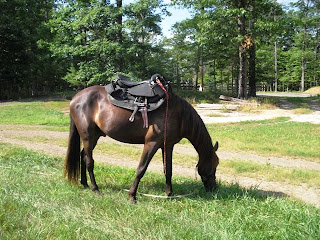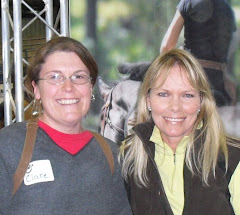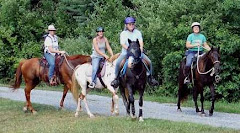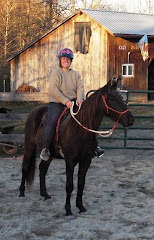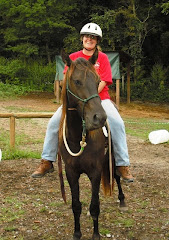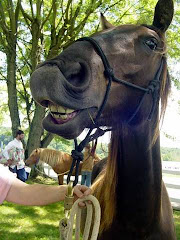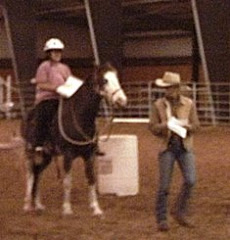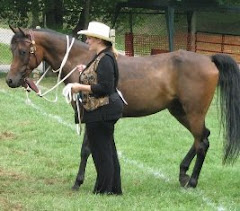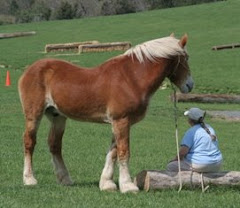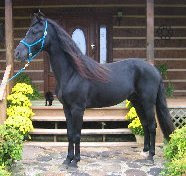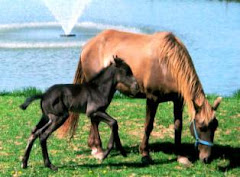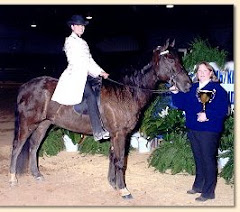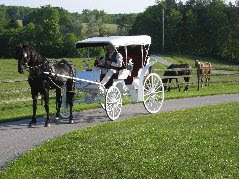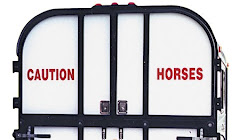
The "secrets" to winning all of the Games - every one of them - have been hiding in plain sight. Who would have thought? I had a huge
BFO insight this evening while playing with Guinness and I want to share it with you guys!!
Prerequisites to PlayYour horse must feel safe and comfortable. He must know that you will not hurt him intentionally and that you are looking out for him (smashing horse flies and scratching where he asks are good tactics). Try at all costs to avoid doing things "to" the horse, but instead ask him to help you out. This includes hoof picking, grooming, trailer loading, vet care, you name it. Make it a principle in your life with your horse. Clicker training helps a ton with this because it provides a clear structure for communication plus incentive for the horse.
Step 1: Find the "game" in the Game Think of what you are wanting the horse to learn to do - not just DO but LEARN TO DO.
Then think of how you could turn it into a game that a toddler or 8 year old kid would want to play. Think of a few simple rules and a clear goal/reward. Really break it down into something that you can convey to your horse. If you can't do that, whatever you do, don't try to play it with your horse until you can!! Remember, you want this to be a Win-Win game.
Step 2: Make 'em beg to playPut some treats in your pouch (and perhaps even his dinner as a jackpot) and mosey out to the play area. I even put out an empty feed pan to emphasize that I might be worth seeking out. Then deliberately ignore your horse until he comes to check you out. It is
ok for him to gently sniff and explore your treat pouch. Just NO biting, pinned ears or rudeness of any kind. If you've been clicker training already, he will know that mugging you isn't the way to win treats. Use your stick if needed to protect your space until he sweetly approaches and asks to play. Yup, make him ask. Those little nudges to your pouch would be an "ask". So could staring at you intently with ears forward, showing you his feed pan, offering behaviors, etc.
Step 3: Allow them to feel successfulStart by playing a few simple things that they already know. For instance, Guinness loves to fetch objects, to smile, and to park out. When I ask him for these behaviors, he is confident about responding and earning his reward (which might be just a good brief scratch, at this point).
Step 4: Release all pressureAfter a few little successes, take all pressure off of him by sitting down, turn slightly away, looking hazily off into the distance, "grazing", rolling, or whatever. Let him take some deep breaths and lower his head, if he so desires.
Step 5: Be happy to resume play when he asks you toWhen he gives you a sign that he wants you to do more (see Step 2), bring up your life (stand tall & make eye contact) and then ask clearly for him to do something, keeping in mind the game that you'd like it to morph into. Be precise. Have a small but clear goal in mind. If he doesn't comply, completely disregard it (see Step 4) and wait until he asks you to play some more! DON'T NAG. Trust me, he will soon figure out that he wants to keep YOU engaged with him. ;-) When he achieves the goal, click/treat, and wait for him to ask for more play. If he tries, but gets tangled up, very clearly redirect him in SLOW motion, then TAG firmly where was - intentionally missing him. When he tries, allow him to win but maybe a much lesser reward than if he really figured it out (say, perhaps a stroke on the nose instead of a treat).
Step 6: Be progressiveGradually add longer duration or more precision. In exchange, give better rewards. As I get closer to my ultimate goal for the session, I start to dole out bits of grain or apples, instead of just alfalfa cubes or cheerios. Between each burst of activity, wait until he gives you the sign that he is ready for more.
Step 7: JackpotWhen he reaches the goal for the session, click (perhaps lots of times for emphasis) and dump the jackpot of grain or something else blissful into his pan. Leave him alone to enjoy it. Then say goodbye and turn him out with his buddies. He will tell them that he just had the best "date" ever. Repeat this whole sequence a few sessions in a row, and I'd bet that he will be galloping across the field to try to get you to come play!
*********************************
This is how Guinness and I played the Circling Game this evening, progressing up to 6 laps without correction in each direction at liberty. I was totally neutral with my hands behind my back, except I did stand tall and kept some energy in my body while I wanted him to continue to move. I really exaggerated tilting my head at his rear when I wanted him to disengage and come in. If he came in before I asked, I stroke his nose once, then backed him out and resent him in the same direction. I asked for him to work up to 6 laps in one direction, before switching to the other, to reinforce that I wanted him to continue in the direction that I'd asked for. Whenever he'd stop, I'd say out loud "where is the horse?" in a voice just like I'd use to play peek-a-boo,
smile, and turn in slow motion in the direction of travel until I spotted his rump. Then I'd slow motion tag that spot firmly. He'd be sure to leap out of the way just in time. After a few repetitions, as soon as I'd say "where is the horse?" and think about turning and he'd resume moving in the correct direction.
Now that I feel that he totally understands the game of "keep going in the direction that I sent you until I call you in," I'm going to progress into rewarding only a particular gait. This evening, he was so into it that he was offering to canter so that he could get his laps done faster, without any increase in pressure from me. Next time, we will go from walking to cantering because he is still having difficulty finding and maintaining a consistent trot (due to his ability to both trot & pace). Cantering seems to be his favorite gait.
Now I understand Linda Parelli's comment about needing to use treats as incentive until she got more savvy about the psychology of PLAYING with her horses. I could see now how the treats will soon become secondary to stimulating his play drive, at least once beyond the learning phase for each behavior.
Super wow.
PS - In my experience, these games are best learned at liberty, if at all possible. Some horses feel pressure and react differently merely with a lead line attached to their halter.. When you take off the halter, "all that's left is the truth!"
 Last Monday, fellow PPG member and veterinarian, Anna Simms, came out to give Guinness a tune-up.
Last Monday, fellow PPG member and veterinarian, Anna Simms, came out to give Guinness a tune-up. She recommended several stretches, but overall believed most issues to be developmental in nature.
She recommended several stretches, but overall believed most issues to be developmental in nature. Anyway, during this whole thing Guinness was a champ. He even held his head down while we took turns doing weird things to his ear. While we were at it Anna commented, "I can't believe that he is allowing us to do all of this to him!" I think that he knew we were trying to help him out. ;-)
Anyway, during this whole thing Guinness was a champ. He even held his head down while we took turns doing weird things to his ear. While we were at it Anna commented, "I can't believe that he is allowing us to do all of this to him!" I think that he knew we were trying to help him out. ;-)














